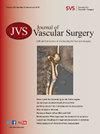Impact of preoperative risk factors on 5-year survival after fenestrated/branched endovascular aortic repair
IF 3.9
2区 医学
Q1 PERIPHERAL VASCULAR DISEASE
引用次数: 0
Abstract
Objective
To investigate which preoperative factors most impact the 5-year survival of patients undergoing fenestrated/branched endovascular aortic repair (F/BEVAR) and to identify modifiable elements that, if time allows, should be actively managed and adequately controlled preoperatively.
Methods
Patients treated for aortic aneurysms with complex anatomy using either patient-specific company-manufactured or off-the-shelf F/BEVAR devices were included. The exposure of interest was aneurysm type (group I: type I-III thoracoabdominal aneurysms vs group II: type IV thoracoabdominal aneurysms vs group III: juxtarenal or suprarenal aneurysms), and the primary outcome was 5-year risk of all-cause mortality. Generalized linear models were used to estimate each group’s crude 5-year risk of death and the 5-year risk of death across groups. Each preoperative factor was added to the model individually, and a change in estimate was calculated between the new risks and the crude risk. Preoperative factors with a change of estimate of ≥10% were used to create an inverse probability of treatment weights for multivariable analysis.
Results
A total of 408 F/BEVAR patients were included, of whom 71.6% were male (mean age: 72.0 ± 7.9 years). Eleven of the 22 preoperative factors analyzed had a change in estimate ≥10%. The greatest changes in estimates were observed for history of congestive heart failure (CHF), arrhythmia, overweight, obesity, and chronic obstructive pulmonary disease. Almost 60% of patients with CHF in group I died within 5 years. Current smoking or overweight at the time of F/BEVAR increases the 5-year risk of death more significantly than having a history of myocardial infarction. After adjustment, patients in group I had a significantly higher risk of 5-year all-cause mortality than those in group III (log-rank, P value = .0082).
Conclusions
The present findings suggest that cardiac arrhythmias, CHF, overweight, obesity, chronic obstructive pulmonary disease, and aneurysm diameter above 7 cm are the most relevant preoperative factors that impact the 5-year survival after F/BEVAR. More specifically, CHF and arrhythmias should be used to alter patient selection and identify those individuals more likely to benefit from repair. Moreover, modifiable risk factors such as weight loss and smoking cessation during the surveillance period before the F/BEVAR procedure might improve survival in this population. Considering that, preoperatively, many patients are periodically evaluated by a vascular surgery team until the aneurysm diameter meets criteria for repair, a multidisciplinary approach that could address these modifiable risk factors might be an impactful strategy.
术前风险因素对血管内主动脉修补术后 5 年生存率的影响
目的研究哪些术前因素对接受主动脉腔内修复术(F/BEVAR)的患者的5年存活率影响最大,并确定在时间允许的情况下应积极管理和充分控制的术前可改变因素:方法:纳入使用患者特制的公司生产或现成的 F/BEVAR 装置治疗解剖结构复杂的主动脉瘤的患者。动脉瘤类型(I组:I-III型胸腹主动脉瘤(TAAA) vs II组:IV型TAAA vs III组:并子或肾上动脉瘤)和5年全因死亡风险是主要研究结果。采用广义线性模型估算各组的粗略 5 年死亡风险和跨组 5 年死亡风险。每个术前因素都被单独添加到模型中,并计算新风险与粗风险之间的估计值变化。利用估计值变化≥10%的术前因素创建治疗逆概率权重,进行多变量分析:结果:结果:共纳入 408 例 F/BEVAR 患者,其中 71.6% 为男性(平均年龄:72.0±7.9 岁)。在分析的 22 个术前因素中,有 11 个因素的估计值变化≥10%。充血性心力衰竭(CHF)病史、心律失常、超重、肥胖、慢性阻塞性肺病的估计值变化最大。第一组近 60% 的充血性心力衰竭患者在 5 年内死亡。与心肌梗死病史相比,F/BEVAR术时吸烟或超重会更显著地增加5年死亡风险。经调整后,I组患者的5年全因死亡风险明显高于III组患者(对数秩p值=0.0082):本研究结果表明,心律失常、CHF、超重、肥胖、慢性阻塞性肺病和动脉瘤直径超过 7 厘米是影响 F/BEVAR 术后 5 年生存率的最相关术前因素。更具体地说,心房颤动和心律失常应被用来改变患者的选择,并确定那些更有可能从修复术中获益的患者。此外,在 F/BEVAR 术前监测期间减轻体重和戒烟等可改变的风险因素可能会提高这类人群的存活率。考虑到许多患者在术前会定期接受血管外科团队的评估,直到动脉瘤直径达到修复标准,因此采用多学科方法来解决这些可改变的风险因素可能是一种有影响力的策略。
本文章由计算机程序翻译,如有差异,请以英文原文为准。
求助全文
约1分钟内获得全文
求助全文
来源期刊
CiteScore
7.70
自引率
18.60%
发文量
1469
审稿时长
54 days
期刊介绍:
Journal of Vascular Surgery ® aims to be the premier international journal of medical, endovascular and surgical care of vascular diseases. It is dedicated to the science and art of vascular surgery and aims to improve the management of patients with vascular diseases by publishing relevant papers that report important medical advances, test new hypotheses, and address current controversies. To acheive this goal, the Journal will publish original clinical and laboratory studies, and reports and papers that comment on the social, economic, ethical, legal, and political factors, which relate to these aims. As the official publication of The Society for Vascular Surgery, the Journal will publish, after peer review, selected papers presented at the annual meeting of this organization and affiliated vascular societies, as well as original articles from members and non-members.

 求助内容:
求助内容: 应助结果提醒方式:
应助结果提醒方式:


